1. Introduction and Goals
1.1. Requirements Overview
The application runs online. It also makes use of Solid Pods to not keep the information centralized, in order to preserve user’s privacy. In this way, it decentralizes most of the user’s data. Users will be shown a map where they can add locations, review scores, comments, etc. to create their own personalized maps. Each user will also be able to fully manage the information they provide to the application.
The full list of requirements of the application can be found in the assignment page.
1.2. Quality Goals
The requirements to be met are the following:
-
Availability : The system must have the capacity so the access to the data is totally reliable and consistent for users in order to make their operations with the system.
-
Decentralization : All the information used by the system must be provided by the users, or had given the system the permissions in order to obtain that information.
-
Testability : The system must be testable in order to make a robust, secure and bug free system.
-
Secure : The system will carry out checks on potentially dangerous decisions for the user, such as to provide personal data to the system to make more personal the interaction with the system. We will also ensure that the requests and responses between client and the API are not compromised.
-
Accessibility/Usability : The system must be easy to use for beginners or people without previous technical knowledge. Likewise, the system should provide the necessary help to the user to be able to navigate through the program without any doubt, in addition to having to be accessible to all people. In order to do that, we decided to follow a minimalist rounded style.
1.3. Stakeholders
| Role/Name | Contact | Expectations |
|---|---|---|
Council of Brussels |
The entity that hire us to deliver the LoMap site. They should help to find the main requirements. |
|
Teachers |
The teachers of the subject, who will support us as required. |
|
Developers |
The students of this team that are going to develop the project. They also will manage all the architecture |
|
Final users |
The future users of the site when it’s published. They can help to find some important requirements. |
|
Solid community |
Users and developers related with the Solid Project. Since this project will use Solid, the community could be interested and also could help us in the process. |
2. Architecture Constraints
2.1. Technical constraints
| Constraint | Explanation |
|---|---|
Solid |
We must store the shared information in a personal Pod according to the SOLID principles. The data is stored in a decentralized way. |
GitHub |
We must track the code and share it in a public repository of GitHub. |
Continuous integration system |
The application has to be accessible and deployed using a continuous integration system. |
2.2. Organizational constraints
| Constraint | Explanation |
|---|---|
The team |
We are a group of three, and we should get along with each other, to not hinder the work. |
Deadlines |
We will try to finish our own issues with one or two margin days, to be able to solve the problems that can come out. |
Meetings |
We must have frequently meetings to know the updates of everyone. At least to weekly, one in our laboratory session. |
2.3. Conventions
| Constraint | Explanation |
|---|---|
Documentation |
We will follow the arc42 template |
Language |
The project will be done in English to reach more public and find more information. |
Design |
The application will have a simple aesthetic and its interface should be intuitive. |
3. System Scope and Context
3.1. Business Context

| Constraint | Explanation |
|---|---|
User |
Users interact with system by adding new places and being able to see the list of places that they have added. |
Solid PODS |
Solid PODS have information about user’s addresses. They can also let access to specific users to share their places. |
OpenStreetMap API |
The OpenStreetMap API is used to show a map with the places that the user has added. It is also used to let the user select in a map the place he wants to add. Lastly, it is also used for the autocomplete feature. |
3.2. Technical Context
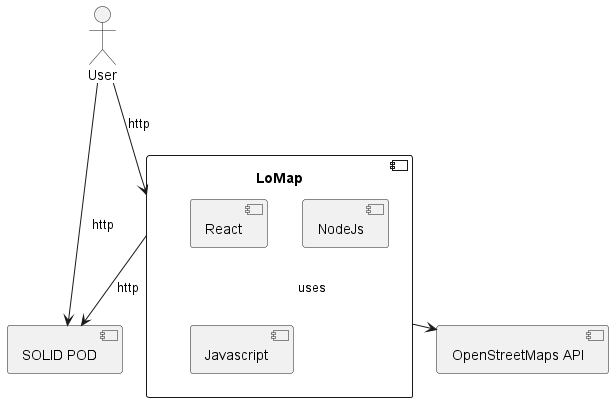
| Technical Elements | Description |
|---|---|
SOLID specification |
Set of design principles for writing clean, maintainable, and scalable code that we will be using in this project. |
SOLID PODs |
All the personal information of the users will be stored in "Pods" in order to follow the SOLID principles and build an app that takes in count user privacy, these pods will be fully stored locally in the user machine. |
GitHub |
We are going to be using GitHub as the control version software, GitHub is a virtual workspace for developers where we can store our code, and keep track of changes and issues. |
React.js |
For the frontend we are going to use React, React is a widely-used JavaScript library that offers high flexibility and modularity, it also has a large community which will be useful in case of future problems during the development of the app. |
4. Solution Strategy
4.1. Technology decisions
We have made the following technology decisions:
-
IDEs:
-
Some of us use IntelliJ and others Visual Studio Code to develop.
-
-
Frameworks: React for the frontend and Jest for testing.
-
Version control: GitHub. One branch per person.
-
We will work with both master and dev branches and then each team member will have its own branch. From our point of view, this is the best way for organizing our code updates minimizing collisions as much as possible.
-
-
Languages:
-
Javascript: As we decided to work with Node.js and React.js, the language we will use is Javascript.
-
JSX: Syntax extension to Javascript.
-
YAML: Data serialization language that used for writing the GitHub workflow script.
-
Java: For Gatling load testing.
-
Cucumber: For E2E testing.
-
-
External APIs: OpenStreetMap API. Mainly because it’s completely free, not like Google Maps, which was our first option. However, it´s a very used API too.
-
Backend technology: Node.js. Javascript runtime environment.
-
We decided to work with Node because it is a well-known backend technology and also one of the best ways to implement SOLID Pods. The example project used it, so we were motivated to try it out.
-
-
Frontend technology: React.js. Frontend library.
-
As mentioned above, the example written in React made us the choice easier. We do not have previous experience with frontend frameworks so its popularity and ease of learning was what made us to choose this technology.
-
4.2. Decisions about the top-level decomposition of the system
Our system will follow an MVC architecture. In this way, the visual part will clearly be separated from the database requests and then both of them will be coordinated by the controller part.
4.3. Decisions on how to achieve key quality goals
| Quality goal | How to achieve |
|---|---|
Availability |
Making sure that all the interactions the users make with our application are totally reliable and consistent. We will ensure that the system will do what it is supposed to. |
Testability |
Making most of the functions testable. This will let us create unit tests for these functions, and thus we will minimize the number of bugs. |
Principle of data Minimisation |
Ensuring that data are used only for their specific purpose, limiting the retention period and their accessibility to what is necessary. With decentralization and by doing a strict control of permissions. This means users will only be able to access the data they are supposed to. |
Accessibility/Usability |
Making a user-friendly and easy to use interface. This means we will work on features like color contrast, keyboard accessibility, etc |
4.4. Relevant organizational decisions
-
Communication
-
We use Teams for our online meetings.
-
We also have a Discord team if we need it.
-
We left the task distribution written with GitHub Issues.
-
We have created a Whatsapp group for short questions or messages.
-
It is important to mention that even, although we use these channels, all decisions are always documented on the GitHub Wiki.
-
-
"No day before" policy
-
We have decided that all work will be done a couple of days before the deadline. This way, we avoid any potential last minute problems.
-
-
Language
-
The project will be done in English and the communication between the team members will be in Spanish (our mother tongue).
-
5. Building Block View
5.1. White-box Overall System

- Motivation
-
The LoMap application lets the user add and manage personal places of interest around the world. Its structure is designed in an almost full decentralized way, ensuring user’s privacy. This is achieved using PODs.
- Contained Building Blocks
| Block name | Description |
|---|---|
User |
It is the person who uses the application and who owns the Pod. |
LoMap |
It is the application that allows the user to manage his places. |
Map API |
It is the API that allows the user to visualize the places on a map and also allows the autocompleting function. |
Pod |
It is the personal data store of the user. It is used to store the places and the all the information about them. |
5.2. Level 2

- Motivation
-
Inside LoMap, the Frontend is connected with the SolidAPI to manage PODs.
- Contained Building Blocks
| Block name | Description |
|---|---|
MyPlaces |
Shows the user’s saved places in a map and a list. |
AddPlace |
Lets the user add a new place selecting it on a map. |
Social |
Lets the user see the places of his friends. |
Settings |
Lets the user change the app settings. |
Profile |
Lets the user manage his profile information. |
SolidApi |
It is the API that allows the Frontend to communicate with the Pod. |
6. Runtime View
6.1. Logging into the application
The user will be able to view all his places in the map and in a sidebar with all the information about the place.

6.2. Adding a new place
The user will be able to add any selected place in the map and add any information about it. The user will be able to add a place by clicking on the map and then clicking on the Add button. The place will be added to his Pod.
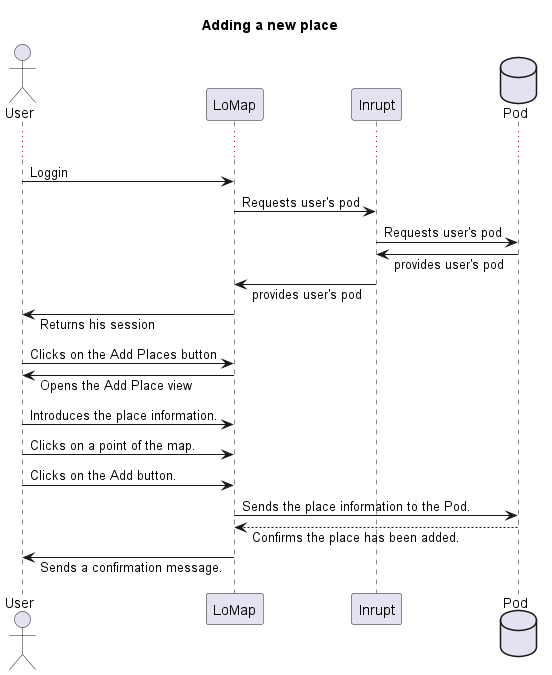
6.3. Viewing a place
The user will be able to view all his places in the map and in a sidebar with all the information about the place.
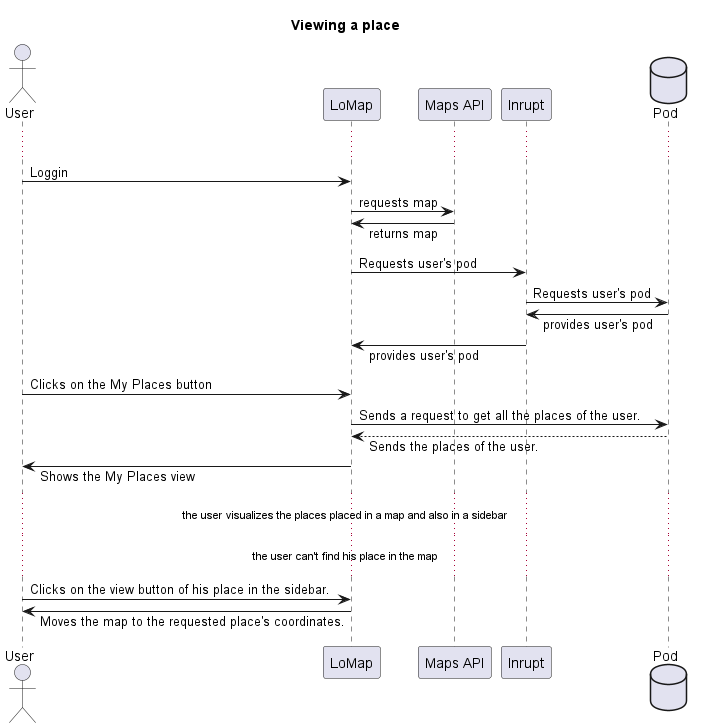
7. Deployment View
7.1. Infrastructure Level 1

- Motivation
-
For the production phase it will be deployed with GitHub Pages. Above is the Deployment view of the production stage.
- Quality and/or Performance Features
-
We have chosen work just with Front to simplify the structure. In the production phase, the user experience should be maximized with a good internet connection, but this is something we cannot control.
7.2. Infrastructure Level 2
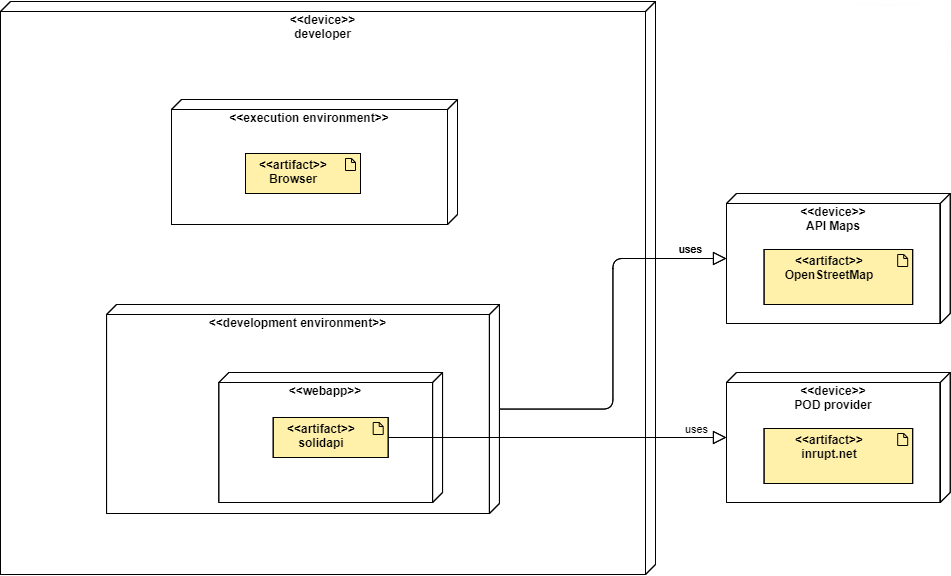
- Motivation
-
For development and testing the execution environment will be on each student’s machine. But for the production phase it will be deployed with GitHub Pages . Above is the development/testing environment.
- Quality and/or Performance Features
-
All hosted on the developer’s pc.
8. Cross-cutting Concepts
8.1. Domain model
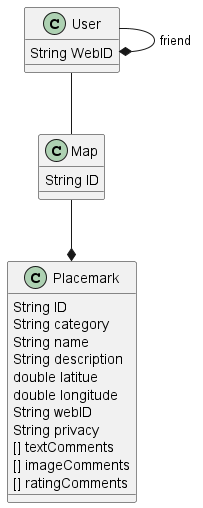
8.2. Domain concepts
| Concept | Description |
|---|---|
Map |
It’s the main part of the interface, we obtain it through OpenStreetMap API. The map is where the user can mark selected places a watch places marked by their friends. |
User |
We only will save the ID of the users and the list of IDs of their friends in the site. |
Placemark |
A Placemark identifies a location on the map. Placemarks are created by the users and once is created they can add rating, pictures, description … We won’t save any of that in our database. All that information will be stored in the user’s pod. |
9. Design Decisions
9.1. AD-01: Front-End technology: React
-
Status: Accepted
-
Context: We had to choose the Front-End technology to use in our web development.
-
Decision: We decided for React due to its huge community to solve our posible future problems. The other option was Angular or Vue, but the minimalism style of React made us selected it to make are work clearer. Vue is like the best of both worlds but the fact that it’s not supported by a big company, it has less support and popularity, takes us back.
-
Consequences: In this way we will take our first steps in React, hoping to solve our problems easily.
9.2. AD-02: Back-End technology: Node.js
-
Status: Accepted
-
Context: We had to choose the Back-End technology to use in our web development.
-
Decision: As we selected JavaScript as our language code, we have guided our decision to Node.js. Its one of the most used network apps, so it gave us trust. For example, the last time I read one statics about back-end technology, Node.js had 49% of popularity. In this decision we didn´t have much doubt
-
Consequences: From now, we will start learning to work with Node.js. None of us has worked with Node earlier, so we wish we had few problems.
9.3. AD-03: Database server: MariaDb
-
Status: Rejected
-
Context: We started thinking about which database server use in our project. Most of our data will be stored in PODs following the SOLID principles, so the database has lower priority.
-
Decision: We had to choose between a relational or non-relational database. The most of us had worked before with HSQLDeveloper so this could have been an option, but didn´t win the spot. We selected, may change later, to try using MariaDb to experiment with a different database. A disadvantage that we read is that Node.js, the backend technology selected, works worst with relational databases.
-
Consequences: For now, we will try to work with MariaDb but this may change in the future.
9.4. AD-04: Definitive Database server: MongoDb
-
Status: Rejected
-
Context: At first we thought using MariaDB as it is explained above. However, the fact that we will work with Node.js and that it doesn´t work well with relational databases, warned us.
-
Decision: As we haven´t started to implement yet, we decided to change to a non-relational database to take less risk. Some of us had worked with it before, and it’s easy to learn.
-
Consequences: We will use MongoDb as a database.
9.5. AD-05: Definitive API Maps: OpenStreet Maps
-
Status: Accepted
-
Context: At first we thought using Google Maps because we are used to it. Some of us had worked with it before in another subject. But when we searched more, we have seen that Google Maps API has a monthly limit of free requests.
-
Decision: The range of decision is not very big, so we read about OpenStreet Maps and, as it is completely free and also popular, changed our decision.
-
Consequences: We will use OpenStreet Maps.
9.6. AD-06: Postman
-
Status: Rejected
-
Context: We had trouble to start working at te backend. Mainly because it´s new for us and abstract. So to make it easier, we looked for a platform to let us see what we are doing.
-
Decision: We chose Postman API Platform, which is an API platform for building and using APIs. It let us see the process of the REST methods and experiment with the connection between MongoDB and Node.
-
Consequences: We will use Postman API Platform.
9.7. AD-07: Format Specification for PODs: JSON
-
Status: Rejected
-
Context: We had to choose a format to save the data in the SOLID pods. The options where JSON, JSON-LD , or RDF.
-
Decision: We have decided to use JSON because we are more used to it.
-
Consequences: Our app writes and reads files from pods in JSON.
9.8. AD-08: Format Specification for PODs: JSON-LD
-
Status: Accepted
-
Context: One of the requirements of this assignment is that there must exist interoperability between the data stored by the different applications. In this issue from the LomapSpec repository there was a discussion about which could be the best option.
-
Decision: Despite not reaching an agreement, we have chosen to follow the JSON-LS format. It´s a point in between JSON and RDF.
-
Consequences: We have to update our code in SolidAPI to follow the JSON-LS format, but this won´t be a big trouble.
9.9. AD-09: No longer use the database
-
Status: Accepted
-
Context: First we started with just the database until we learned how to manage pods. When we put the pods in action in our project, we no longer needed the database, because everything was loaded from the POD according to our web interface
-
Decision: Work without database.
-
Consequences: We must quit the connection with the database in our project.
10. Quality Requirements
10.1. Quality Tree
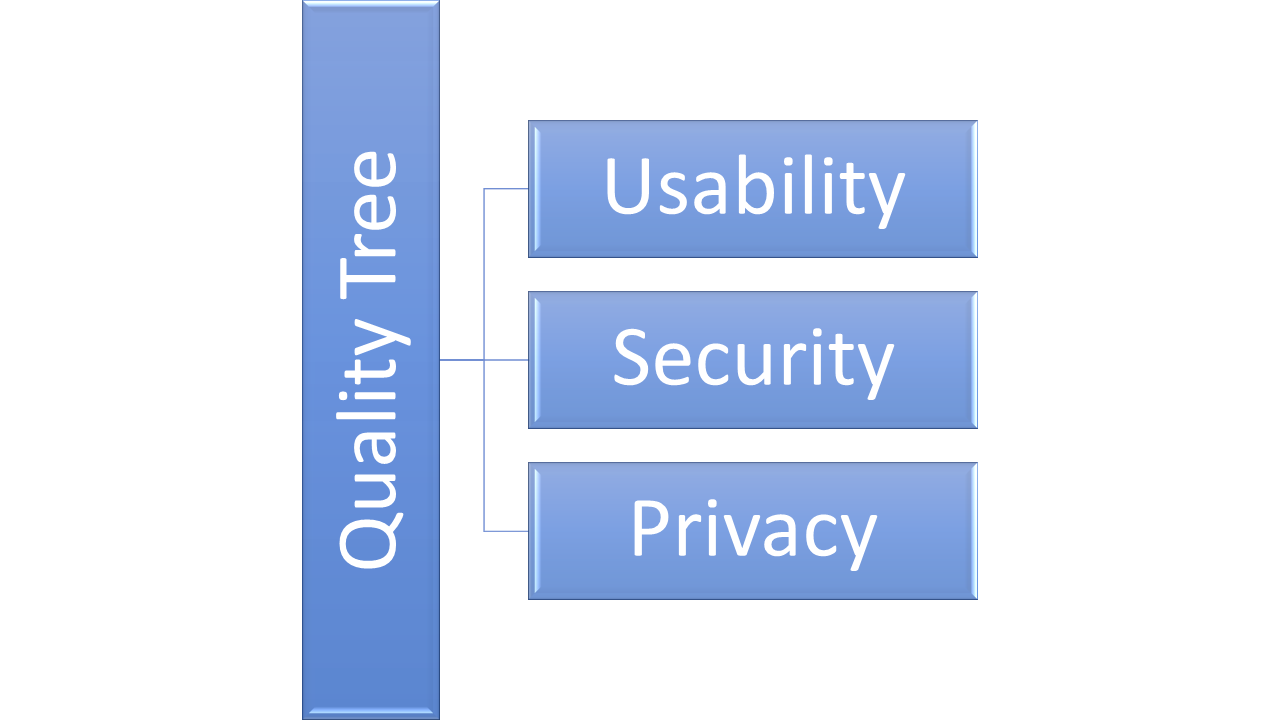
10.2. Quality Scenarios
| Quality attribute | Scenario | Approach |
|---|---|---|
Usability |
Quick and easy navigation for not experienced users. |
The main objective is to ensure that the user can intuitively navigate through the application, and understand how it works in a simple way. |
Security |
The application needs to give confidence to be used without any risk. |
We guarantee in the most efficient way that user data is protected by decentralised data storage . |
Privacy |
We do not want a fraudulent use of the user’s personal information |
Only the information of the user and/or friends will be shown if the user requests it, otherwise private information will never be shown. |
11. Risks and Technical Debts
11.1. Risks
| Risk | Problem description | Consideration | Measures to be taken |
|---|---|---|---|
High |
Huge project |
We are under pressure to have the project completed to what is needed by the deadline. |
It is therefore necessary to have good communication and a good working dynamic among the members of the team. |
Medium |
Lack of knowledge about the technologies |
Most of the technologies used in the project are new to the team members. This requires extra effort at the beginning to learn them. |
Spend time learning and getting to know the new technologies. |
Medium |
Time availability |
Due to the workload between different subjects and the problems of time compatibility. |
It is necessary to have a good organisation and distribution of time between the members of the team. |
Medium |
SOLID server availability |
The project is based on the SOLID platform and is therefore essential for its proper functioning. We are susceptible to bugs and changes within the technology. Unfortunately we cannot control or alter Solid’s development. |
We have no other option but to rely on SOLID, so we give the user different POD providers to choose from. |
11.2. Technical debts
| Technical debts | Considerations |
|---|---|
Slow data transfer |
The use of SOLID to store and share all the information we work with in the project. This results in longer waiting times than we would like. |
Some funcional features |
Due to lack of time we did not have time to implement some features we would like to. We had to prioritise the important functionality of the project. |
Some usability and features |
We wanted to implement the application in a way that it would be usable by all users and also that it would be adaptable and responsive to different devices, such as mobile, computer or tablet. But due to lack of time, we did not complete it. |
12. Glossary
| Term | Definition |
|---|---|
SOLID |
SOLID is a web decentralization project that securely stores users data in private data stores called Pods. |
SOLID Pod |
It’s a data store where users can keep their information. Only selected users will be able to access to that information. |
JavaScript |
JavaScript is a high level programming lenguage very used int the World Wide Web, especially in the client side. |
Node.js |
Node is an open source back-end enviroment that lets developers use JavaScript for server side scripting. |
React |
It’s an open source JavaScript library that helps building efficient interfaces. |
API |
Software that helps two or more computer programs to comunicate to each other. |
OpenStreetMap API |
OpenStreetMap has an editing API for fetching and saving raw geodata from/to the OpenStreetMap database. |
About arc42
arc42, the Template for documentation of software and system architecture.
By Dr. Gernot Starke, Dr. Peter Hruschka and contributors.
Template Revision: 7.0 EN (based on asciidoc), January 2017
© We acknowledge that this document uses material from the arc 42 architecture template, http://www.arc42.de. Created by Dr. Peter Hruschka & Dr. Gernot Starke.
